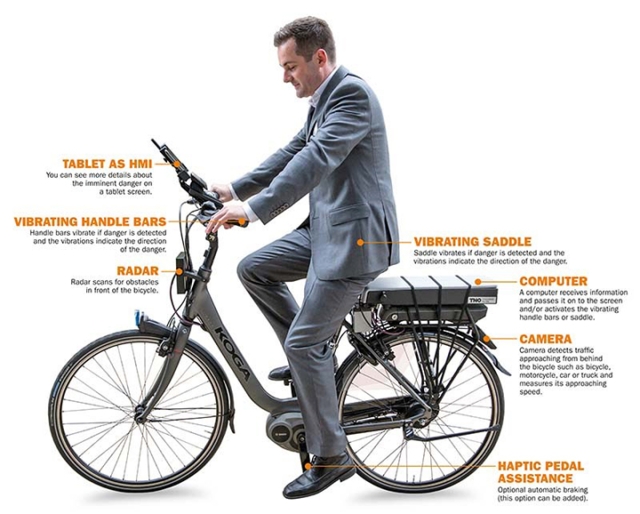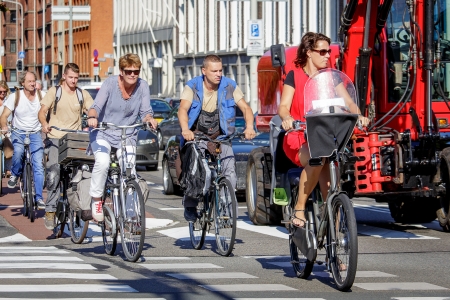In contrast with car occupants, cyclists are unprotected in a crash or fall. That is why cyclists are vulnerable road users. There are several measures that may improve cyclist safety. In particular, these regard infrastructure, vehicles (both the bicycle itself and safety systems for motor vehicles) and education.
Safe infrastructure
In general, the infrastructure is sound when cyclists are physically separate from heavier and faster motor vehicles. In space: by separate bicycle tracks; in time: by conflict-free traffic lights (see SWOV fact sheet Sustainable Road Safety). At a more detailed level, it is important that the cycling infrastructure complies with the design guidelines, for example those relating to width, bends and crossing facilities. The quality of the cycling infrastructure is also important – for example bumps and obstacles, such as high kerbs and bollards, should be avoided. For more details on a safe cycling infrastructure, see SWOV fact sheet Infrastructure for pedestrians and cyclists.
Increased bicycle stability
With two wheels, a bicycle is, by definition, a balance vehicle. This makes bicycles less stable, especially when being (dis)mounted, and at low speeds. Several developments are intended to make bicycles more stable. An example is saddles that automatically descend at low speeds which will make it easier for cyclists to have both feet on the ground, e.g., when mounting or dismounting, and will make it less easy to fall over [49].
Another development is smart, active steering support, developed by TU Delft in collaboration with bicycle manufacturer Gazelle [50]. A smart motor in the steering column supports steering as soon as the cyclist threatens to fall over, which could be particularly helpful in preventing a cyclist to fall over at lower speeds.
A completely different method to improve bicycle stability is adding a third wheel. This makes it easier for cyclists with balance problems to dismount when having stopped. For now, rigid tricycles are on the market, which have two rear or front wheels. A disadvantage of the so-called rigid tricycles is that, in certain situation, they may tip, similar to the tipping hazards of three-wheeled mobility scooters [51]. This can be solved by using a second front wheel, both tilting, which allows all three wheels to stay put. The 2022 NVCC road safety prize was won by Piet Noordzij, who had built a prototype of such a tricycle [52]. To what extent such a tricycle will gain a foothold in the market and will allow large-scale production, needs to be investigated further.
Intelligent bicycle
Bicycles may also be provided with intelligent technology, which may alert cyclists to hazardous situations. In the Netherlands, TNO in collaboration with the Fietsersbond (Dutch Cycling Federation) and Roessingh Research & Development, did a lot of development work in this field (see Figure 5; [53]). For now, such intelligent bicycles are not on the market yet, and little news is published on this issue. Moreover, it remains to be seen whether and to what extent the cycling industry will follow through on these developments.

Figure 5. Prototype of the intelligent bicycle, developed by TNO. Source: [54].
Safety systems for trucks
At the end of 2019, European regulation 2019/2144 was published [55]. Among other things, it lays down rules about how vehicle safety systems should protect vulnerable road users, among whom cyclists. From July 2024 onwards, all new vehicles must meet these requirements. The following three issues are central:
- Advanced systems that can detect pedestrians and cyclists in the vicinity of the front or side of a bus or truck and can issue a warning or can prevent crashes with these vulnerable road users.
- Bus and truck designs with improved direct visibility of vulnerable road users from the driver seat, while blind spots in front and to both sides of the driver are virtually eliminated.
- Head impact zone enlargement in cars and delivery vans for vulnerable road users and to ensure their injuries are less serious in case of a crash.
The regulation also lays down rules concerning intelligent speed assistance, distraction warning and reversing detection, which with proper use will benefit the safety of cyclists and other vulnerable road users.
Education programmes
There are several road safety education programmes for cyclists of all ages. They often focus on enhancing knowledge and improving skills. The traffic test for children aged 11/12 (in the 8th grade of primary school) organised by the Dutch Road Safety Association (VVN) focuses on cycling [56]. Targeting older cyclists, the programme CycleOn aims to enable them to cycle safely as long as possible, and to encourage them to take measures to that end themselves.
Not much is known about the effects and impact of these and other cycling education programmes on cyclist behaviour and crashes. Evaluations, if any, are often small-scale and based on self-reported behaviour (see SWOV fact sheet Traffic education). For Education programmes outside schools, such as the CycleOn initiative, it has sometimes proven hard to find enough participants [57].
Communication campaigns
Bicycle helmet campaigns generally result in an increase of helmet use, but the effect is sometimes temporary [58]. The latest large-scale bicycle helmet campaign also showed an effect on helmet use; over five times as many young children (aged 4-8) wore helmets as before the campaign [59]. The size of the effect proved to be strongly related to the intensity of the annual campaign activities (see SWOV fact sheet Bicycle helmets). In Denmark, (voluntary) bicycle helmet use has been successfully promoted for almost twenty years. Bicycle helmet promotion consists of a combination of public campaigns, communication/education, improved helmet design and helmet availability. The promotion is based on motivations and barriers for helmet use emerging from polls and interviews. In addition, helmet use has been monitored since 2004. This shows helmet use to have increased from 6% to 48% since then, and to be highest among school children (aged 6 to 9) at 94% [60] [61].
